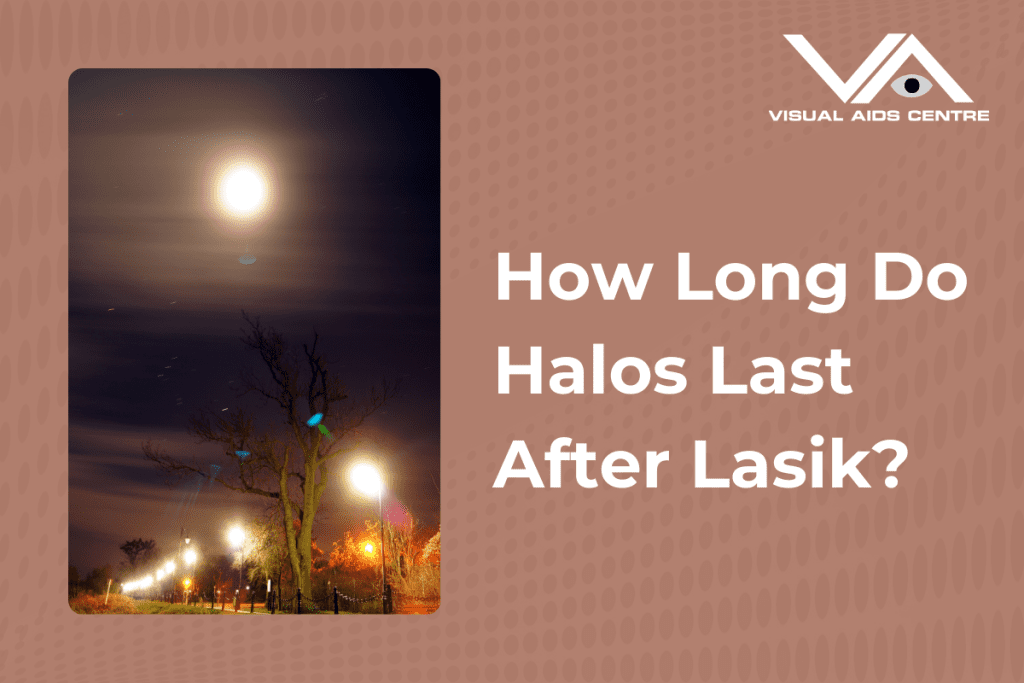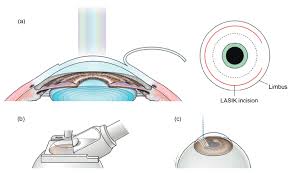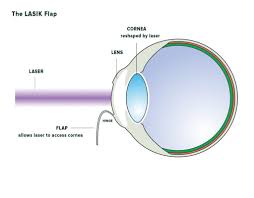Table of Contents
ToggleLASIK eye surgery has revolutionized the field of vision correction, helping millions of people see clearly without the need for glasses or contact lenses. However, like any surgical procedure, LASIK comes with its set of post-operative visual phenomena, one of the most common being halos.
If you’re considering LASIK or have already undergone the procedure, you might be wondering: “How long do halos last after LASIK?” This blog aims to provide you with a detailed, informative, and research-backed answer to this question.

Understanding Halos After LASIK
Halos are a common side effect experienced by LASIK patients. They appear as rings or circles around light sources, particularly noticeable at night or in low-light conditions. Halos occur due to the way light rays enter the eye and are refracted by the cornea, which has been reshaped during LASIK surgery.
Why Do Halos Occur After LASIK?
In LASIK surgery, a laser meticulously reshapes the cornea to correct refractive errors such as myopia, hyperopia, and astigmatism.
This reshaping, while improving overall vision, can also lead to changes in how light enters the eye. When light passes through the newly modified cornea, it can scatter, causing the halo effect.
The severity and duration of halos can depend on several factors:
- Corneal Edema (Swelling): During LASIK surgery, a laser is used to reshape the cornea. This process can cause temporary swelling, leading to light scattering and the perception of halos.
- Corneal Healing: As your cornea heals, the scattering of light usually diminishes.
- Pupil Size: Larger pupils can exacerbate the halo effect, especially in dim environments.
- Pre-existing Conditions: Individuals with higher prescriptions or pre-existing eye conditions may experience more pronounced halos.
- Irregularities in Corneal Shape: The reshaping of the cornea can create minor irregularities that affect light refraction.
Typical Duration of Halos After LASIK
The duration of halos varies from patient to patient, but here is a general timeline:
Short-Term (First Few Days to Weeks)
- Initial Days: Halos are most prominent immediately following surgery, usually within the first 24 to 48 hours. During this period, your eyes are acclimating to the new shape of the cornea.
- First Week: Many patients report a significant reduction in halo intensity after the first week. This is when the majority of initial healing occurs.
Medium-Term (First Few Months)
- 1 to 3 Months: Halos continue to diminish as the cornea heals and stabilizes. By the conclusion of the third month, the majority of patients notice substantial improvement.
- 3 to 6 Months: For many, halos are barely noticeable, if present at all. The healing process is largely complete, allowing for a more stable vision.
Long-Term (6 Months and Beyond)
- 6 Months to 1 Year: Any residual halos usually disappear entirely, leaving patients with clear, unimpeded vision. In rare cases, some patients may experience minor and infrequent halos beyond this period.
Factors Influencing the Duration of Halos
Individual Healing Rates
Everyone’s body heals at a different rate. Younger patients and those with healthier corneas may experience faster recovery times.
Surgical Technique
Advances in LASIK technology, such as wavefront-guided LASIK, can minimize the occurrence of visual disturbances like halos.
Pre-Existing Eye Conditions
Conditions such as dry eye or high myopia can prolong the presence of halos. It’s important to discuss your medical history with your surgeon to understand how these factors could affect your recovery.
Tips to Manage Halos After LASIK
Follow Post-Operative Instructions
Adhering to your surgeon’s post-operative care instructions is crucial for a swift recovery. This involves applying prescribed eye drops and attending follow-up appointments.
Use Artificial Tears
Dry eyes can exacerbate halos. Using artificial tears can keep your eyes moist and reduce visual disturbances.
Avoid Bright Lights
Minimize exposure to bright lights and glare, especially during the first few weeks after surgery.
Wear Sunglasses
Protecting your eyes from intense light sources with sunglasses can help mitigate halos during the day.
Night Driving Precautions
If halos affect your night driving, consider limiting nighttime driving until your vision stabilizes. Anti-reflective lenses can also help minimize glare.
Report Persistent Symptoms
If halos persist beyond the expected healing period, schedule a follow-up appointment with your LASIK surgeon. They can evaluate your eye health and recommend potential treatments such as additional laser adjustments or specialized contact lenses.
When to Seek Help
While halos are typically a temporary side effect, certain situations warrant immediate attention from an eye care professional:
- Severe Visual Disturbances: If halos are accompanied by significant vision loss or other severe visual disturbances, seek medical advice promptly.
- Persistent Dry Eyes: Chronic dry eyes can prolong the presence of halos. Your doctor can recommend treatments such as punctal plugs or medicated eye drops to alleviate dryness.
- Worsening Symptoms: If your symptoms worsen over time rather than improving, it is essential to consult your surgeon for a thorough evaluation.
Summing Up
Halos after LASIK are a common and often temporary side effect. For most patients, halos diminish significantly within the first few months post-surgery and disappear entirely within six months to a year. Understanding this helps set realistic expectations and prepares you for the recovery journey. Always follow your surgeon’s advice and keep them informed of any concerns you have during your healing process.
By being well-informed and proactive, you can enjoy the benefits of LASIK with minimal discomfort and disturbances. Your journey to a clearer vision is not just about the surgery but also about understanding and managing the healing process effectively.
Note: Always consult a qualified eye care professional for personalized medical advice. This blog aims to offer general information and should not substitute for professional medical advice.













